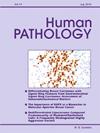肾周脂肪肌样假瘤:13 例系列病例及文献综述》(Perinephric Myxoid Pseudotumor of Fat: A Series of 13 Cases and Literature Review.
IF 2.7
2区 医学
Q2 PATHOLOGY
引用次数: 0
摘要
肾周脂肪肌样假瘤(PMPF)是最近描述的一种罕见的腹膜后肿块形成性病变,其临床意义主要在于模仿各种软组织肿瘤。由于不明原因,它通常发生在伴有非肿瘤性肾脏疾病和/或 2 型糖尿病(DMT2)的男性患者中。文献中总共报道了 55 个病例。最近,我们遇到了 13 例具有特殊组织学特征的此类肿块;因此,我们试图调查我们的经验,并回顾文献中的临床病理特征。我们的系列研究证实,PMPF 常发生于成年男性患者(11/13,85%),平均年龄为 66 岁,通常与肾脏疾病并存,如 DMT2(2/13,15%)、终末期肾病(ESRD)(5/13,39%)、肾囊肿(4/13,31%)、并发或既往肾肿瘤(2/13;15%)和骨髓瘤/淋巴瘤(2/13;15%)。组织学评估显示,脂肪瘤性肿块通常表现为不同数量的脂肪坏死、肌样变性、淋巴浆细胞炎症,并缺乏不典型的高色素基质纺锤细胞。异常组织学特征包括髓外造血(1/13,8%)、血色素沉积(4/13,31%)和成熟平滑肌小缕(6/13,46%)。所有受检病例的 MDM2 均为阴性,且未显示 IgG4+/IgG+ 浆细胞比率增高。我们的研究证实了 PMPF 的临床和病理特征,并扩大了其组织学范围,强调了该实体作为良性假瘤的重要性,应将其纳入其他含脂肪腹膜后肿块(尤其是分化良好的脂肪肉瘤)的鉴别诊断中。本文章由计算机程序翻译,如有差异,请以英文原文为准。
Perinephric myxoid pseudotumor of fat: A series of 13 cases and literature review
Perinephric myxoid pseudotumor of fat (PMPF) is a recently described and rare retroperitoneal mass-forming lesion whose clinical significance chiefly involves mimicry of a variety of soft tissue tumors. For unknown reasons, it commonly occurs in male patients with underlying non-neoplastic renal diseases and/or type 2 diabetes (DMT2). A total of 55 cases have been reported in the literature. Recently, we have encountered 13 such masses with peculiar histologic features; thus, we sought to investigate our experience and review the clinicopathologic characteristics of the literature. Our series confirms that PMPF frequently occurs in adult male patients (11/13, 85%), with an average age of 66 years, and commonly co-occurs with renal disease, such as DMT2 (2/13, 15%), end-stage renal disease (ESRD) (5/13, 39%), renal cysts (4/13, 31%), concurrent or prior renal neoplasia (2/13; 15%), and myeloma/lymphoma (2/13; 15%). Histologic evaluation shows lipomatous masses commonly showing variable amounts of fat necrosis, myxoid degeneration, lymphoplasmacytic inflammation and lacking atypical hyperchromatic stromal spindle cells. Unusual histologic features include extramedullary hematopoiesis (1/13, 8%), hemosiderin deposition (4/13, 31%), and small wisps of mature smooth muscle (6/13, 46%). All cases tested were negative for MDM2 and did not show an increased ratio of IgG4+/IgG+ plasma cells. Our study confirms the clinical and pathologic features of PMPF and expands its histologic spectrum, underscoring the importance of this entity as a benign pseudotumor which should be included in the differential diagnosis of other fat-containing retroperitoneal masses, particularly well-differentiated liposarcoma.
求助全文
通过发布文献求助,成功后即可免费获取论文全文。
去求助
来源期刊

Human pathology
医学-病理学
CiteScore
5.30
自引率
6.10%
发文量
206
审稿时长
21 days
期刊介绍:
Human Pathology is designed to bring information of clinicopathologic significance to human disease to the laboratory and clinical physician. It presents information drawn from morphologic and clinical laboratory studies with direct relevance to the understanding of human diseases. Papers published concern morphologic and clinicopathologic observations, reviews of diseases, analyses of problems in pathology, significant collections of case material and advances in concepts or techniques of value in the analysis and diagnosis of disease. Theoretical and experimental pathology and molecular biology pertinent to human disease are included. This critical journal is well illustrated with exceptional reproductions of photomicrographs and microscopic anatomy.
 求助内容:
求助内容: 应助结果提醒方式:
应助结果提醒方式:


